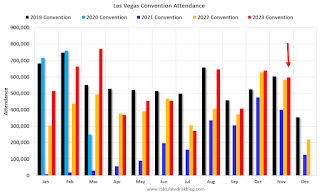by Calculated Risk on 12/30/2023 02:11:00 PM
Saturday, December 30, 2023
Real Estate Newsletter Articles this Week: Case-Shiller: National House Price Index Up 4.8% year-over-year
At the Calculated Risk Real Estate Newsletter this week:
• Case-Shiller: National House Price Index Up 4.8% year-over-year in October
• FHFA’s National Mortgage Database: Outstanding Mortgage Rates, LTV and Credit Scores
• Inflation Adjusted House Prices 2.4% Below Peak
• Question #10 for 2024: Will inventory increase further in 2024?
• Fannie and Freddie Serious Delinquencies in November: Single Family Mostly Unchanged, Multi-Family Increased
• Freddie Mac House Price Index Increased in November; Up 6.3% Year-over-year
This is usually published 4 to 6 times a week and provides more in-depth analysis of the housing market.
You can subscribe at https://calculatedrisk.substack.com/
Schedule for Week of December 31, 2023
by Calculated Risk on 12/30/2023 08:11:00 AM
Happy New Year! Wishing you all the best in 2024.
The key report this week is the December employment report on Friday.
Other key indicators include the December ISM manufacturing, December vehicle sales and November Job Openings.
The NYSE and the NASDAQ will be closed in observance of the New Year’s Day holiday
10:00 AM: Construction Spending for November. The consensus is for a 0.5% increase in construction spending.
7:00 AM ET: The Mortgage Bankers Association (MBA) will release the results for the mortgage purchase applications index.
 10:00 AM ET: Job Openings and Labor Turnover Survey for November from the BLS.
10:00 AM ET: Job Openings and Labor Turnover Survey for November from the BLS. This graph shows job openings (black line), hires (dark blue), Layoff, Discharges and other (red column), and Quits (light blue column) from the JOLTS.
Jobs openings decreased in October to 8.73 million from 9.35 million in September
10:00 AM: ISM Manufacturing Index for December. The consensus is for the ISM to be at 47.1, up from 46.7 in November.
2:00 PM: FOMC Minutes, Meeting of December 12-13, 2023
 Late: Light vehicle sales for December.
Late: Light vehicle sales for December.The Wards forecast is for 15.7 million SAAR in December, up from the BEA estimate of 15.32 million SAAR in November (Seasonally Adjusted Annual Rate).
This graph shows light vehicle sales since the BEA started keeping data in 1967. The dashed line is the current sales rate.
8:15 AM: The ADP Employment Report for December. This report is for private payrolls only (no government). The consensus is for 130,000, up from 103,000 jobs added in November.
8:30 AM: The initial weekly unemployment claims report will be released.
 8:30 AM: Employment Report for December. The consensus is for 158,000 jobs added, and for the unemployment rate to increase to 3.8%.
8:30 AM: Employment Report for December. The consensus is for 158,000 jobs added, and for the unemployment rate to increase to 3.8%.There were 199,000 jobs added in November, and the unemployment rate was at 3.7%.
This graph shows the jobs added per month since January 2021.
10:00 AM: the ISM Services Index for December.
Friday, December 29, 2023
Dec 29th COVID Update: Hospitalizations Increased
by Calculated Risk on 12/29/2023 07:33:00 PM

| COVID Metrics | ||||
|---|---|---|---|---|
| Now | Week Ago | Goal | ||
| Hospitalized2🚩 | 21,597 | 20,050 | ≤3,0001 | |
| Deaths per Week2 | 1,464 | 1,545 | ≤3501 | |
| 1my goals to stop weekly posts, 2Weekly for Currently Hospitalized, and Deaths 🚩 Increasing number weekly for Hospitalized and Deaths ✅ Goal met. | ||||
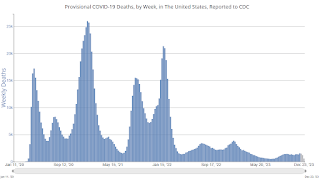 Click on graph for larger image.
Click on graph for larger image.This graph shows the weekly (columns) number of deaths reported.
And here is a new graph I'm following on COVID in wastewater as of Dec 28th:
 This appears to be a leading indicator for COVID hospitalizations and deaths.
This appears to be a leading indicator for COVID hospitalizations and deaths.Philly Fed: State Coincident Indexes Increased in 25 States in November (3-Month Basis)
by Calculated Risk on 12/29/2023 02:24:00 PM
From the Philly Fed:
The Federal Reserve Bank of Philadelphia has released the coincident indexes for the 50 states for November 2023. Over the past three months, the indexes increased in 25 states, decreased in 21 states, and remained stable in four, for a three-month diffusion index of 8. Additionally, in the past month, the indexes increased in 18 states, decreased in 21 states, and remained stable in 11, for a one-month diffusion index of -6. For comparison purposes, the Philadelphia Fed has also developed a similar coincident index for the entire United States. The Philadelphia Fed’s U.S. index increased 0.7 percent over the past three months and 0.3 percent in November.Note: These are coincident indexes constructed from state employment data. An explanation from the Philly Fed:
emphasis added
The coincident indexes combine four state-level indicators to summarize current economic conditions in a single statistic. The four state-level variables in each coincident index are nonfarm payroll employment, average hours worked in manufacturing by production workers, the unemployment rate, and wage and salary disbursements deflated by the consumer price index (U.S. city average). The trend for each state’s index is set to the trend of its gross domestic product (GDP), so long-term growth in the state’s index matches long-term growth in its GDP.
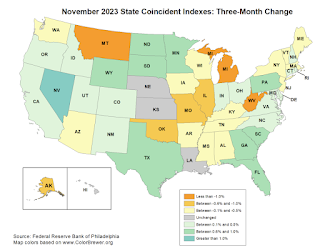 Click on map for larger image.
Click on map for larger image.Here is a map of the three-month change in the Philly Fed state coincident indicators. This map was all red during the worst of the Pandemic and also at the worst of the Great Recession.
The map is split between positive and negative on a three-month basis.
Source: Philly Fed.
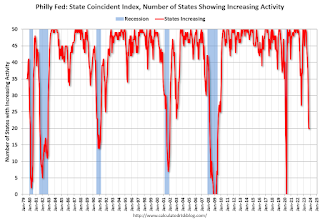 And here is a graph is of the number of states with one month increasing activity according to the Philly Fed.
And here is a graph is of the number of states with one month increasing activity according to the Philly Fed. In November, 20 states had increasing activity on a single month basis, including minor increases.
Freddie Mac House Price Index Increased in November; Up 6.3% Year-over-year
by Calculated Risk on 12/29/2023 11:11:00 AM
Today, in the Calculated Risk Real Estate Newsletter: Freddie Mac House Price Index Increased in November; Up 6.3% Year-over-year
A brief excerpt:
On a year-over-year basis, the National FMHPI was up 6.3% in November, from up 5.6% YoY in October. The YoY increase peaked at 19.1% in July 2021, and for this cycle, bottomed at up 0.9% YoY in April 2023. ...There is much more in the article. You can subscribe at https://calculatedrisk.substack.com/
As of November, 9 states and D.C. were below their previous peaks, Seasonally Adjusted. The largest seasonally adjusted declines from the recent peak were in Idaho (-4.2%), Utah (-2.0%), Louisiana (-1.7%), and Colorado (-1.4%).
For cities (Core-based Statistical Areas, CBSA), here are the 30 cities with the largest declines from the peak, seasonally adjusted. Austin continues to be the worst performing city.
...
I’ll have an update on the House Price Battle Royale: Low Inventory vs Affordability soon.
Question #10 for 2024: Will inventory increase further in 2024?
by Calculated Risk on 12/29/2023 08:35:00 AM
Today, in the Real Estate Newsletter: Question #10 for 2024: Will inventory increase further in 2024?
Brief excerpt:
Earlier I posted some questions on my blog for next year: Ten Economic Questions for 2024. Some of these questions concern real estate (inventory, house prices, housing starts, new home sales), and I’ll post thoughts on those in the newsletter (others like GDP and employment will be on my blog).There is much more in the article. You can subscribe at https://calculatedrisk.substack.com/
I'm adding some thoughts, and maybe some predictions for each question.
10) Housing Inventory: Housing inventory decreased sharply during the pandemic to record lows in early 2022. Since then, inventory has increased, but is still well below pre-pandemic levels. Will inventory increase further in 2024?
...
First, a brief history. Here are a few times when watching existing home inventory helped my analysis.
Starting in January 2005, I was very bearish on housing, but I wasn’t sure when the market would turn. Speculative bubbles can go on and on. However, the increase in inventory in late 2005 (see red arrow on graph) helped me call the top for house prices in 2006.Several years later, in early 2012, when many people were still bearish on housing, the plunge in inventory in 2011 (blue arrow on graph below) helped me call the bottom for house prices in early 2012 (see The Housing Bottom is Here).
...
Somewhat lower mortgage rates - and time - will likely lead to more new listings in 2024. Still, mortgage rates will remain well above the pandemic lows, and therefore new listings will be depressed again in 2024.
The bottom line is inventory will probably increase year-over-year in 2024. However, it seems unlikely that inventory will be back up to the 2019 levels. Inventory is always something to watch!
Thursday, December 28, 2023
Friday: Chicago PMI
by Calculated Risk on 12/28/2023 08:22:00 PM
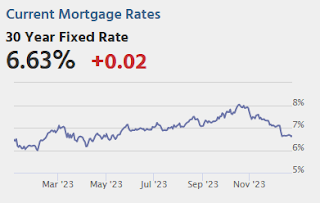
Friday:
• At 9:45 AM: Chicago Purchasing Managers Index for December.
Hotels: Occupancy Rate Increased 0.5% Year-over-year
by Calculated Risk on 12/28/2023 03:11:00 PM
As anticipated ahead of the holidays, U.S. hotel performance fell from the previous week, according to CoStar’s latest data through 23 December. ...The following graph shows the seasonal pattern for the hotel occupancy rate using the four-week average.
17-23 December 2023 (percentage change from comparable week in 2022):
• Occupancy: 43.9% (+0.5%)
• Average daily rate (ADR): US$131.97 (-0.9%)
• Revenue per available room (RevPAR): US$57.90 (-0.4%)
emphasis added
 Click on graph for larger image.
Click on graph for larger image.The red line is for 2023, black is 2020, blue is the median, and dashed light blue is for 2022. Dashed purple is for 2018, the record year for hotel occupancy.
Las Vegas November 2023: Visitor Traffic Up 1% YoY; Convention Traffic Up 3%
by Calculated Risk on 12/28/2023 01:54:00 PM
From the Las Vegas Visitor Authority: November 2023 Las Vegas Visitor Statistics
With highlights including the SEMA tradeshow in the first week of the month and of course, the inaugural Formula 1 Las Vegas Grand Prix on Nov 16‐18, Las Vegas tourism metrics exceeded last November across several categories, most notably with record ADR and RevPAR.
Visitor volume exceeded 3.29M, ahead of last November by +0.8%, and convention attendance approached 600k, +2.7% YoY.
Overall hotel occupancy was 81.9%, +0.7 pts YoY, as Weekend occupancy reached 88.7% (‐0.9 pts YoY) while Midweek occupancy exceeded last November by 1.4 pts to reach 78.9% for the month. Driven by strong rates during the dates of the F1 race, monthly ADR reached a record $249, +33.7% YoY and RevPAR exceeded $204, +34.8% YoY
 Click on graph for larger image.
Click on graph for larger image. The first graph shows visitor traffic for 2019 (Black), 2020 (light blue), 2021 (purple), 2022 (orange), and 2023 (red).
Visitor traffic was up 0.8% compared to last November.
Update on FirstAm Cyber Attack
by Calculated Risk on 12/28/2023 01:42:00 PM
Update on FirstAm cyber attack (started on Dec 20th). This will impact December house closings. From FirstAm:
"FirstAm.com has been restored (with some limits to functionality). We will continue to post updates on this page as we return to normal business operations."

